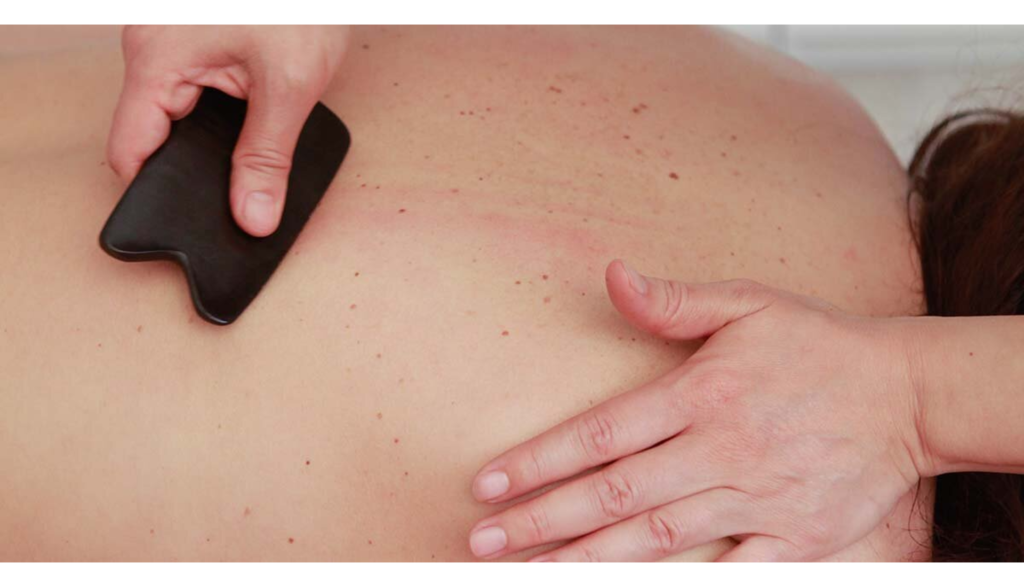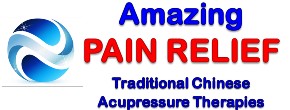
What is – Gua Sha or Chinese Scraping Therapy?
What is – Gua Sha or Chinese Scraping Therapy?
–

–
–
Stimulating your Acupressure Points Works – Amazing !!!
–
–
Gua Sha or Chinese Scraping Therapy
–
Gua sha is the practice of using a tool to apply pressure and scrape the skin to relieve pain and tension. This action causes light bruising, which often appears as purple or red spots known as petechiae or sha.
–
The name gua sha — pronounced gwahshah — comes from the Chinese word for scraping. It may also be called skin scraping, spooning, or coining.
–
According to Traditional Chinese Medicine, qi or chi is energy that flows through the body. Many people believe that a person’s qi must be balanced and flowing freely to ensure their health and wellbeing.
–
People also believe that qi can become blocked, causing pain or tension in the muscles and joints. Gua sha aims to move this blocked energy to relieve aches or stiffness.
–
Traditional East Asian Medicine also views blood stasis or stagnation as a cause of pain and illness. Another aim of gua sha is to move pooled or stagnated blood to relieve symptoms.
–
Some physiotherapists use a version of the technique known as instrument assisted soft tissue mobilization (IASTM). Using a tool instead of the hands during a massage allows a physiotherapist to apply more pressure.
–
Uses
–
Gua sha is most often used to relieve muscle and joint pain. Conditions of the muscles and bones are known as musculoskeletal disorders. Some examples include back pain, tendon strain, and carpal tunnel syndrome.
–
Practitioners claim that gua sha can also benefit the immune system and reduce inflammation. Sometimes, gua sha is used to treat a cold, fever, or problems with the lungs.
–
Small injuries to the body, such as the bruises caused by gua sha, are sometimes known as microtrauma. These create a response in the body that may help to break up scar tissue.
–
Microtrauma may also help with fibrosis, which is a buildup of too much connective tissue when the body heals.
–
Physiotherapists may use IASTM on connective tissue that is not working to move joints as it should. This problem may be due to a repetitive strain injury or another condition. Gua sha is used alongside other treatments, such as stretching and strengthening exercises.
–
Benefits
–
Researchers have carried out small studies on the following groups of people to see if gua sha works:
- women near menopause
- people with neck and shoulder pain from computer use
- male weightlifters, to help with recovery after training
- older adults with back pain
–
Women found that perimenopause symptoms, such as sweating, insomnia, and headaches, were reduced after gua sha.
–
A 2014 study found that gua sha improved the range of movement and reduced pain in people who used computers frequently compared with a control group that had no treatment.
–
In a 2017 study, weightlifters who had gua sha felt that lifting weights took less effort after treatment. This could suggest that the treatment speeds up muscle recovery.
–
Older adults with back pain were treated with either gua sha or a hot pack. Both treatments relieved symptoms equally well, but the effects of gua sha lasted longer Trusted Source.
–
After a week, those who had received gua sha treatment reported greater flexibility and less back pain than the other group.
–
Side effects and risks
–
Gua sha causes tiny blood vessels near the surface of the skin called capillaries to burst. This creates the distinctive red or purple bruises, known as sha.
–
The bruises usually take a few days or a week to heal and can be tender while healing. People can take an over-the-counter painkiller, such as ibuprofen, to help with pain and reduce swelling.
–
A person should protect the bruised area and take care not to bump it. Applying an ice pack can help to reduce inflammation and ease any pain.
–
Gua sha practitioners should not break the skin during the treatment, but there is a risk it could happen. Broken skin increases the possibility of infection, so a gua sha practitioner should always sterilize their tools between treatments.
–
Gua sha is not suitable for everybody. People who should not have gua sha include those:
- who have medical conditions affecting the skin or veins
- who bleed easily
- who take medication to thin their blood
- who have deep vein thrombosis
- who have an infection, tumor, or wound that has not healed fully
- who have an implant, such as a pacemaker or internal defibrillator
–
Is gua sha painful?
–
Treatment is not supposed to be painful, but gua sha deliberately causes bruising, which may cause discomfort for some people. These bruises should heal within a few days.
–
Gua sha tools and technique
–
Traditionally, a spoon or coin would be used to scrape the skin, but in modern practice, therapists use a small, hand-held tool with rounded edges.
–
Gua sha tools are often weighted to help the practitioner who is doing the procedure to apply pressure.
–
Practitioners of traditional East Asian medicine see some materials as having an energy that will support healing — these materials include bian stone, jade, and rose quartz. Medical grade stainless steel is often used for IASTM or when gua sha is done in a clinic.
–
Practitioners will apply oil to the area of the body that is being treated, which allows the therapist to move the tool across the skin more smoothly.
–
The gua sha practitioner will press the tool into the body with smooth, firm strokes in one direction. If gua sha is being carried out on the back, or back of the legs, a person may need to lie face down on a massage table.
–
Takeaway
–
Gua sha is used to treat a range of illnesses and disorders, but research has only been carried out on a small number of specific medical conditions. More evidence is needed to confirm whether gua sha is an effective treatment.
–
Gua sha is unlikely to have any serious side effects, but it can be painful for some people. A person who plans to have gua sha should make sure that they go to an experienced practitioner.
–
Source: https://www.medicalnewstoday.com/articles/320397#takeaway
–
–
Please Note:
–
Amazing FOOT SPA, nor our Owners, Partners, Staff, or Associates, do not condone nor condemn any of the preceding information. This information comes directly from the Source noted above, and is provided here for informational purposes only.
–
Our Services and Fees section is what we perform and provide, and none of the information contained therein should be construed as we are implying, nor even suggesting, that any form of health benefit(s) can be gained from the work that we perform, because Traditional Chinese Reflexology, Traditional Chinese Acupressure, and other forms of Non-Invasive Traditional Chinese Healing Practices, mainly for “Pain Relief” is all that we do, and we know of none, nor are we suggesting or implying that any form of health benefit(s) can be gained from the work that we perform.
–
